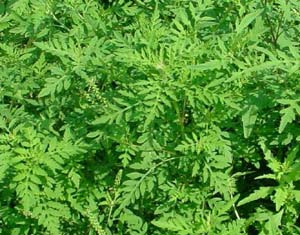
Ragweed (Ambrosia artemisiifolia) is a native, warm-weather annual found throughout North America, usually in sunny sites. It can crowd out garden plants, plus ragweed pollen causes hay fever. Learn to recognize the deeply cut leaves, and pull young plants from moist soil or spray them with an organic herbicide containing acetic acid or clove oil. Seedlings also can be cultivated into submission with a sharp hoe. Mature plants produce slender upright flower spikes that resemble candelabras. Use pruning loppers when cutting down older plants to reduce reseeding.
Weed Control Techniques
Pulling. Most young weeds can be pulled from the soil. They will slide out most easily if you pull them when the soil is wet. Getting the root up is crucial, so think of the main stem as the root's handle, and grasp it as close to the soil line as you can. If you find that the weeds are breaking off at the crown as you pull, slip a kitchen fork, dandelion weeder, or similar tool under the weed, and pry and twist as you pull it up. Weeds that have taproots, such as dandelion and plantain, usually must be pried out. A flexible pair of waterproof gloves will keep your hands comfortable as you weed, and it's good to have a nice sitting pad, too. Let pulled weeds bake in the sun for a day or so before composting them. If pulled weeds are holding mature seeds, compost them separately in a hot, moist pile before using this compost in the garden.

Organic herbicides. There are several herbicides made from natural ingredients. Those that contain clove oil (eugenol) give the best control of young broadleaf weeds. Products containing acetic acid, often in combination with citric acid, do a good job on young grasses. Some products contain both clove oil and acetic acid, so they are useful for a broad variety of weeds. Soap-based herbicides dehydrate leaves by cutting through their protective layer of cutin. All of these types of organic herbicides work best on young weeds and pose only a temporary setback to well-rooted perennial weeds. To minimize damage to neighboring plants, spray only in dry, still weather. To maximize effectiveness, spray young weeds when temperatures are above 70 degrees F and the sun is shining brightly. Be aware that repeated applications of a product containing acetic acid (which is very strong vinegar) can lower the soil's pH, making it more acidic.
Cultivating. Slicing and dicing weeds with a hoe works best when the soil is relatively dry, and the same goes for cultivating with a tiller. With their tops mangled and roots cut, most young weeds will quickly shrivel up and die. Be careful to cultivate only the top inch or two of soil or you may injure nearby garden plant roots and drag new weed seeds to the surface. A sharp hoe works much better than a dull one, so refresh the edge on your hoe with a steel file between weeding sessions. After using either a hoe or tiller to cultivate weeds, go back the next day to nip out any survivors. When battling perennial weeds, you can weaken the plants by chopping them down with a sharp hoe, but it's best to combine hoeing with digging to achieve good control. Never use a tiller in soil that is infested with bindweed, quackgrass, or other weeds that regrow from small pieces of root; they are easily spread by rototilling.
Reducing reseeding. Most weeds reproduce primarily from seeds, and the seeds of some weeds can remain viable when buried in the soil for decades. So it's essential to keep weeds from shedding seeds in the garden. Garden weeds that are neglected until they reach seed-bearing age can be lopped off near the soil line with pruning shears, a stout knife, or a string trimmer with a blade attachment. Cutting back perennial weeds again and again not only reduces reseeding, it also forces the plants to use up food reserves stored in their roots. In a garden that has gone hopelessly weedy, mowing it down promptly, raking out the seed-bearing debris, and starting over next year is a big step in the right direction. Mowing regularly helps keep weeds under control in lawns. When mowing lawns where seed-bearing weeds are present, collect the clippings in a bagger and dispose of them in a shady place.
For more information: visit http://www.garden.org/weedlibrary/?q=show&id=2391
No comments:
Post a Comment